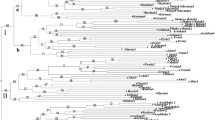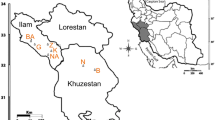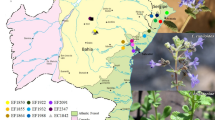Abstract
In Tunisia, Capparis spinosa L. is widely distributed in different geographic areas. Although it has been extensively studied morphologically, the phylogenetic relationships by using molecular markers among Capparis taxa are still unclear. The Inter-Simple Sequence Repeats (ISSR) molecular markers were used to assess the genetic relationship of this species cultivated in the North and the South of Tunisia. Fifteen ISSR primers were analyzed to characterize the genetic profiles of 67 different genotypes. The ISSR markers produced 108 bands ranging from 4 (ISSR8) to 11 (IAM12 and ISSR16) with an average of 7.2. The observed heterozygosity ranged from 0.43 to 0.95 for ISSR7 and IAM12, respectively. The Polymorphic Information Content (PIC) ranged from 0.48 at the UBC808 to 0.85 at IAM12 and eight loci could be classified as useful for genetic mapping (PIC > 0.7). The genetic diversity within a population was high and varied according to the subspecies and bioclimatic zones. Both UPGMA (Unweighted Pair Group Method with Arithmetic mean) and PCoA (Principal Coordinate Analysis) analyses showed that populations from each subspecies grouped together. However, the structure analysis generated more groups than the PCoA plot and UPGMA, which revealed the mixed allelic of the species Capparis spinosa in Tunisia.






Similar content being viewed by others
References
Dogan H, Ercisli S, Temim E, Hadziabulic A, Tosun M, Yilmaz SO, Zia-Ul-Haq M (2014) Diversity of chemical content and biological activity in flower buds of a wide number of wild grown caper (Capparis ovate Desf.) genotypes from Turkey. Comptes Rendus De L Acad Bulgare Des Sci 67:1593–1600
Barbera G (1991) Programme de recherche agrimed: le câprier (Capparis spp) CEE Rapport EUR13617 FR
Fici S (2001) Intraspecific variation and evolutionary trends in Capparis spinosa L. (Capparaceae). Plant Syst Evol 228:123–141
Raja P, Moorthy ND, Kala A, Soosai RS (2013) Extended distribution of Capparis shevaroyensis sund-ragh (Capparaceae) an endemic and vulnerable shrub in peninsular India to southern eastern ghats of tamilnaidu. Indian J Fundam Appl Life Sci 3:137–140
Le Floc ‘h E (1983) Contribution à une étude ethnobotanique de la flore tunisienne. - PubI. Sci. Tunisiennes. Programme «Flore et végétation tunisiennes». Imprimerie Officielle de la République Tunisienne, Tunisia, p 402
Bailey LH (1950) The Standard Cyclopedia of Horticulture. 658 p. Macmillan Company, New York
Tlili N, Nasri N, Saadaoui E, Khaldi A, Triki S (2009) Carotenoid and tocopherol Composition of Leaves, Buds and Flowres of Capparis spinosa Grownl. Wild in Tunisia. J Agric Food Chem 57:5381–5385
Ali-Shtayeh MS, Abu Ghdeib SI (1999) Antifungal activity of plant extracts against dermatophytes. Mycoses 42:665–672
Eddouks M, Lemhadri A, Michel JB (2005) Hypolipidemic activity of aqueous extract of Capparis spinosa L. in normal and diabetic rats. J Ethnopharmacol 98:345–350
Ghorbel A, Ben-Salem FA, Khouildi S, Skouri H, Chibani F (2001) Le câprier; caractérisation et multiplication. Des modèles biologiques à l’amélioration des plantes 157–172
Saadaoui E, Khaldi A, Khouja ML, El-Gazzah M (2007) Etude- de la variabilité morphologique du câprier (Capparis spp.) en Tunisie. Revue des Régions Arides 2:73–527
Pottier-Alapetite G (1979) Flore de la Tunisie: Angiiospermes - Dicotyledones Apétales Dialypétales, Première partie. Imprimerie officielle de la république, Tunisienne, p 651
Higton RN, Akeroyd JR (1991) Variation in Capparis spinosa L. in Europe. Flora Eur 106(2):104–112
Le Floc’h E, Boulos L, Vela E (eds) (2010) Catalogue synonymique commenté de la flore de Tunisie. p 500
Saadaoui E, Guetat A, Tlili N, El Gazzah M, Khaldi A (2011) Subspecific variability of Tunisian wild populations of Capparis spinosa L. J Med Plants Res 5:4339–4348
Rhizoploulou S, Psaras GK (2003) Development and structure of drought-tolerant leaves of the Mediterranean shrub Capparis spinosa L. Ann Bot 92:377–383
Rhimi A, Hannachi H, Hjaoujia S, Boussaid M (2012) The use of morphological descriptors to study variability in wild populations of Capparis spinosa L. (Capparaceae) in Tunisia. Afr J Ecol 51:47–54
Yousfi AH, Bahri AB, Medini M, Rouz S, Rejeb MN, Grabi GZ (2016) Genetic diversity and population structure of six species of Capparis in Tunisia using AFLP markers. CR Biol 339:442–453
Nosrati H, Hosseinpour Feizi MA, Mazinani M, Haghighi AR (2012) Effect of population size on genetic variation levels in Capparis spinosa (Capparaceae) detected by RAPDs. Eur Asian J BioSci 6:70–75
Bhoyar MS, Mishra GP, Naik PK, Murkute AA, Srivastava RB (2012) Genetic variability studies among natural populations of Capparis spinosa from cold arid desert of Trans-Himalayas using DNA markers. Natl Acad Sci Lett 35:505–515
Al-Safadi B, Faouri H, Elias R (2014) Genetic diversity of some Capparis L. species growing in Syria. Br Arch Biol Technol 57:916–926
Ozbek O, Kara A (2013) Genetic variation in natural populations of Capparis from Turkey, as revealed by RAPD analysis. Plant Syst Evol 299:1911–1933
Moubasher H, Abd El-Ghani MM, Kamel W, Mansi M, El-Bous M (2011) Taxonomic considerations among and within some Egyptian taxa of Capparis and related genera (Capparaceae) as revealed by RAPD fingerprinting. Collectanea Botanica 3:29–35. https://doi.org/10.3989/collectbot.2011.v30.003
Gristina AS, Fici S, Siragusa M, Fontana I, Garfi G, Carimi F (2014) Hybridization in Capparis spinosa L.: molecular and morphological evidence from a Mediterranean island complex. Flora 209(12):733–741. https://doi.org/10.1016/j.flora.2014.09.002
Saifi N, Ibijbijen J, Echchgadda D (2011) Genetic diversity of caper plant (Capparis ssp.) from North Morocco. J Food Agric Environ 9:299–304
González A, Coulson M, Brettell R (2002) Development of DNA markers (ISSRs) in mango. Acta Hortic 575:139–143
Borba RS, Garcia MAS, Kovalleski A, Oliveira AC (2005) Dissimilaridade genética de linhagens de Trichogramma Westwood (Hymenoptera: Trichogrammatidae) através de marcadores moleculares ISSR. Neotrop Entomol 34:565–569
Rocha TO, Freitas JS, Santos ESL, Scaldaferri MM (2016) Estimate of genetic diversity in cassutinga (Croton heliotropiifolius) based on molecular markers. Afr J Biotechnol 15:518–523
Trieu LN, Mien NT, Tien TV, Ket NV (2016) Genetic diversity of Panax stipuleanatus Tsai in North Vietnam detected by inter simple sequence repeat (ISSR) markers. Biotechnol Biotechnol Equip 30:506–511
Saghai-Maroof MA, Soliman KM, Jorgensen RA, Allard RW (1984) Ribosomal DNAsepacer-lengtb polymorphism in barley: mendelian inheritance, chromosomal location, and population dynamics. Proc Natl Acad Sci 81:8014–8019
Peakall R, Smouse PE (2012) GENALEX6.5: genetic analysis in. Excel. Population genetic software for teaching and research-an update. Bioinformatics 28:2537–2539
Brookfield JFU (1996) A simple new method for estimating null allele frequency from heterozygote deficiency. Mol Ecol 5:233–257
Tessier C, David J, This P, Boursiquot JM, Charrier A (1999) Optimization of the choice of molecular markers for varietal identification in Vitis vinifera L. Theor Appl Genet 98:171 – 177
Excoffier L, Smouse PE, Quattro JM (1992) Analysis of molecular variance inferred from metric distances among DNA haplotypes: application to human mitochondrial DNA restriction data. Genetics 131:479–491
Huff DR, Peakall R, Smouse PE (1993) RAPD variation within and among natural populations of outcrossing buffalograss [Buchloe dactyloides (Nutt.) Engelm.]. Theor Appl Genet 86:927–934
Pritchard JK, Stephens M, Donnelly P (2000) Inference of population structure using multilocus genotype data. Genetics 155:945–959
Evanno G, Regnaut S, Goudet J (2005) Detecting the number of clusters of individuals using the software STRUCTURE: a simulation study. Mol Ecol 14:2611–2620
Halasz J, Pedryc A, Ercisli S, Yilmaz KU, Hegedus A (2010) S-genotyping supports the genetic relationships between Turkish and Hungarian apricot germplasm. J Am Soc Hortic Sci 135(5):410–417
Ercisli S, Ipek A, Barut E (2011) SSR marker-based DNA fingerprinting and cultivar identification of olives (Olea europaea). Biochem Genet 49:555–561
Caliskan O, Bayazit S, Oktem M, Ergul A (2017) Evaluation of the genetic diversity of pomegranate accessions from Turkey using new microsatellite markers. Turkish J Agric For 41:142–153
Hamrick JL, Godt MJW (1996) Conservation genetics of endemic plant species. In: Avise JL (ed) Conservation genetics case histories from nature. Chapman and Hall, London, pp 281–304
National Institute of Research in Rural Engineering, Waters, and Forests (INRGREF) (2001) Development of the culture of the caper in the West North of Tunisia. Final Scientific Report, Tunisia, p 84
Rivera D, Inocencio C, Obón C, Alcaraz F (2003) Review of food and medicinal uses of Capparis L. subgenus Capparis (Capparidaceae). Econ Bot 57:515–534
Skouri H (2000) Enzymatic polymorphism study at the caper (Capparis spinosa L.). Faculty of the Sciences, University of Tunis II, Tunis, p 96
Santos RC, Queiroz CM, Batista VGL, Silva CRC (2013) Variabilidade de progênies F2 de amendoim geradas por meio de seleção de genitores ISSR-divergentes. Rev Cienc Agron 44:578–586
Soares ANR, Vitória MF, Nascimento ALS, Ledo AS (2016) Genetic diversity in natural populations of mangaba in Sergipe, the largest producer State in Brazil. Genet Mol Res 15:1–12
Khouildi S, Pagnotta MA, Tanzarella OA, Ghorbel A, Porceddu E (2000) Suitability of RAPD (random amplified polymorphic DNA) technique for estimating the genetic variation in natural genotypes of Tunisian and Italian caper (Capparis spinosa L.). Agricoltura-Mediterranea 130:72–77
Saadaoui E, Khaldi A, Khouja ML, El Gazzah M (2009) Intraspecific variation of Capparis spinosa L. in Tunisia. J Herbs Spices Med Plants 15:9–15
Inocencio C, Cowan RS, Alcaraz F, Rivera D, Fay MF (2005) AFLP fingerprinting in Capparis subgenus Capparis related to the commercial sources of capers. Genet Resour Crop Evolut 52:137–144
Mhamdi TM, Ben Haj Ali I, Messaoud C, Boussaid M (2012) Genetic variability of Tunisian wild strawberry tree (Arbutus unedo L.) populations interfered from isozyme markers. Sci Hortic 146:92–98
Benzarti Z (2003) La pluviométrie en Tunisie. Analyse des années très pluvieuses. In: ENS (ed). EAU ET ENVIRONNEMENT - Tunisie et milieux méditerranéens. Lyon, pp. 63–77
Acknowledgements
The authors thank the National Genes Bank of Tunisia Institute and Mss Siwar Nsiri for her comments on an early version of manuscript.
Author information
Authors and Affiliations
Corresponding author
Ethics declarations
Conflict of interest
The authors declare that they have no conflict of interest.
Ethical approval
This article does not contain any studies conducted on human or animal subjects.
Additional information
Publisher’s Note
Springer Nature remains neutral with regard to jurisdictional claims in published maps and institutional affiliations.
Rights and permissions
About this article
Cite this article
Rhimi, A., Mnasri, S., Ben Ayed, R. et al. Genetic relationships among subspecies of Capparis spinosa L. from Tunisia by using ISSR markers. Mol Biol Rep 46, 2209–2219 (2019). https://doi.org/10.1007/s11033-019-04676-z
Received:
Accepted:
Published:
Issue Date:
DOI: https://doi.org/10.1007/s11033-019-04676-z




